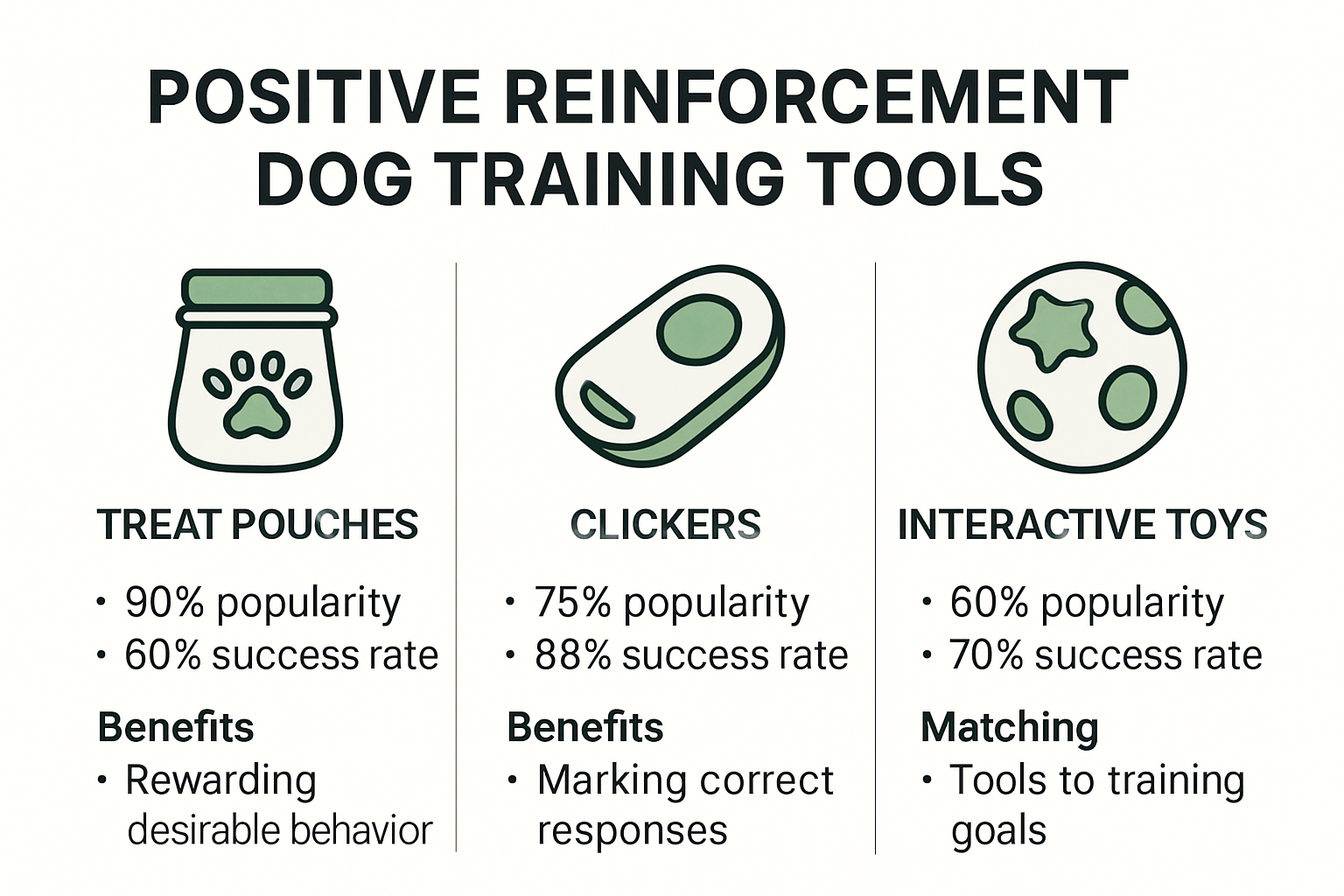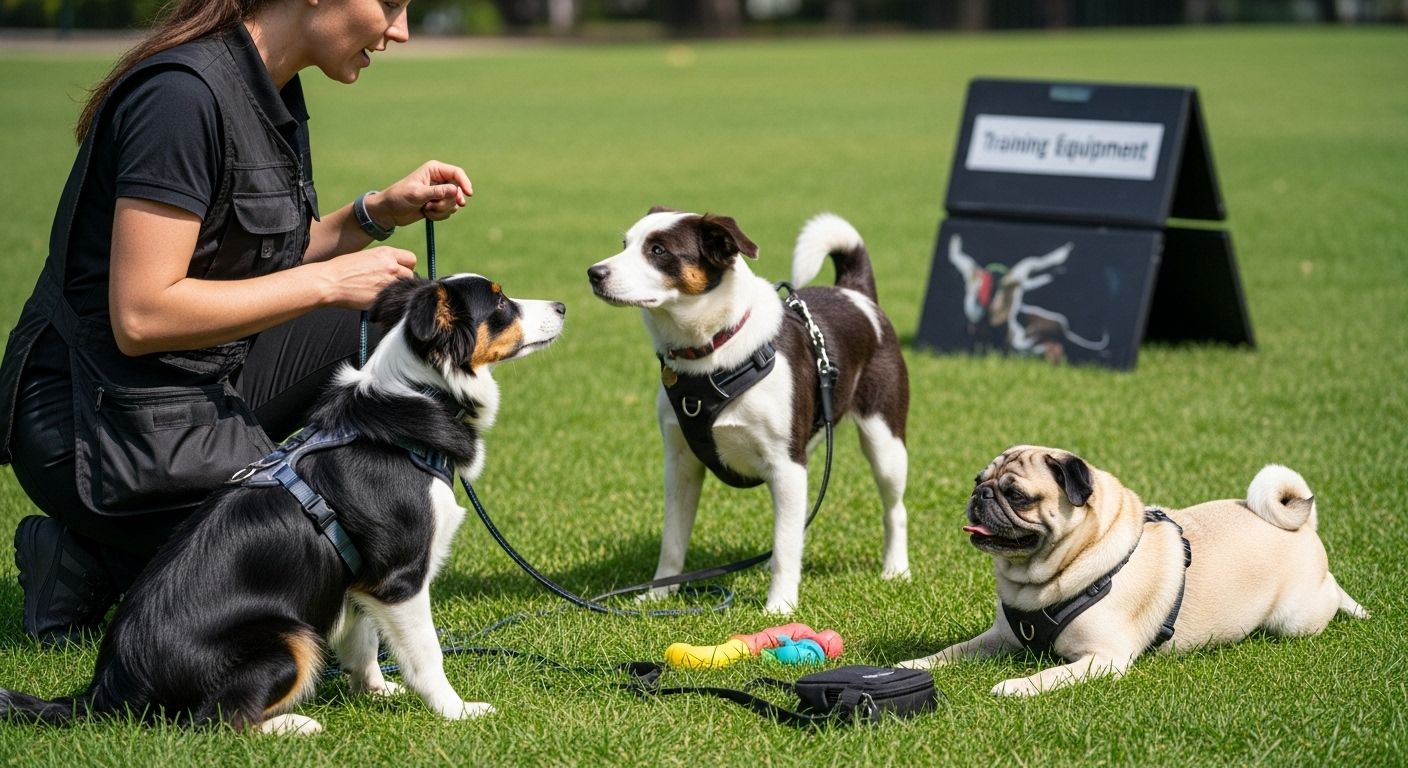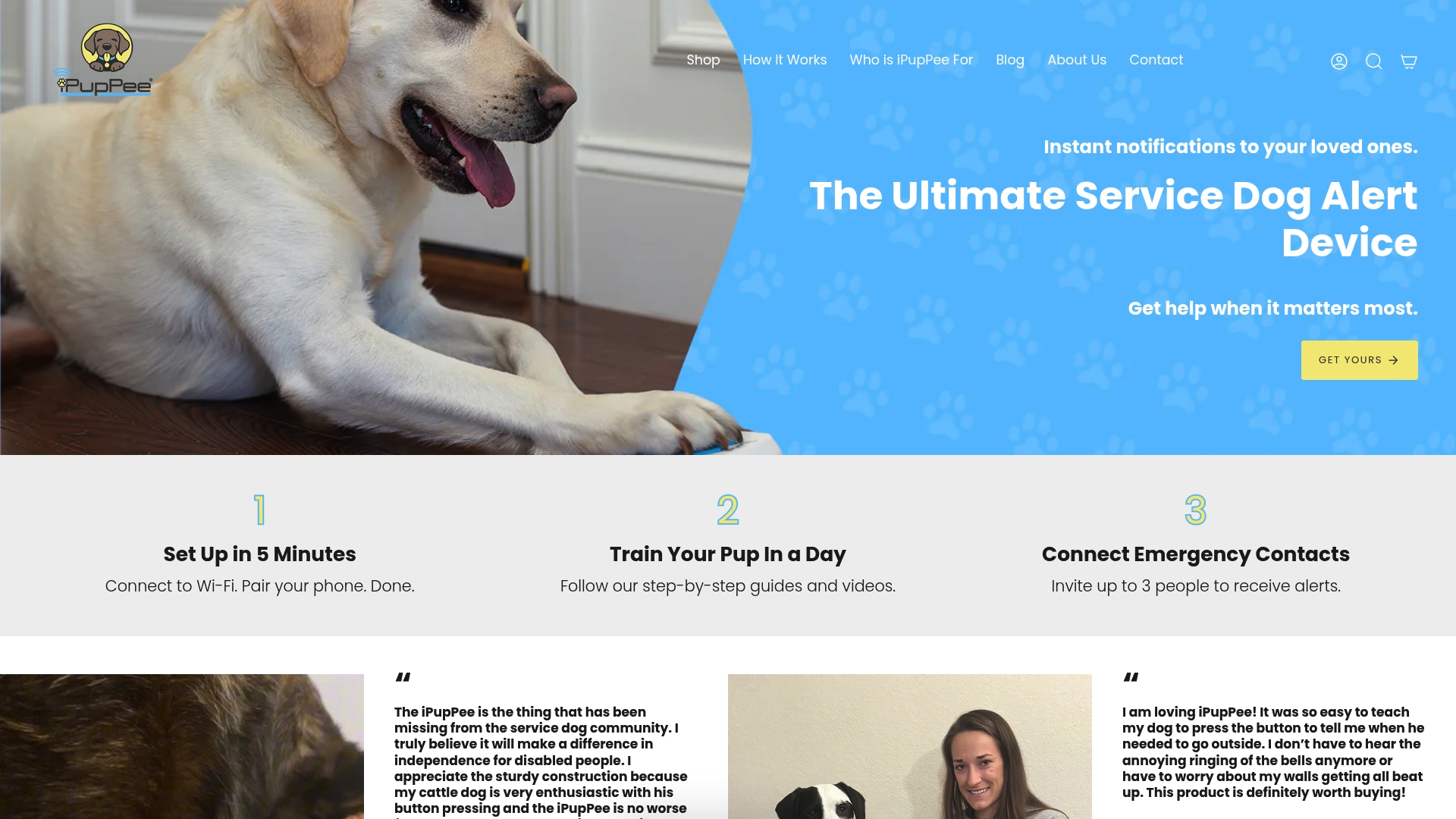Dog training tech keeps getting smarter every year. Now, over 85 percent of dog owners in 2024 use positive reinforcement tools like treat pouches or clickers and the numbers keep climbing. You might think the real difference comes from clever gadgets or high-priced gear. The real secret is surprising. The most effective training tools are often the simplest and most humane methods—ones that build trust and help your dog learn with confidence.
Table of Contents
- Understanding Dog Training Tool Types
- Top Tools For Different Training Needs
- How To Choose The Right Training Equipment
- Safety Tips And Best Practices For Using Training Tools
Quick Summary
| Takeaway | Explanation |
|---|---|
| Use positive reinforcement tools. | Positive reinforcement, such as treat pouches and clickers, effectively encourages desired behaviors without harm. |
| Consider your dog’s individual temperament. | Tailor training tools and methods to match your dog’s personality and response for better outcomes. |
| Avoid harmful training methods. | Steer clear of aversive tools like shock collars; they can lead to behavioral problems and distress. |
| Focus on safety during training. | Prioritize your dog’s comfort and emotional safety by selecting appropriate equipment and monitoring stress levels. |
| Seek professional guidance for advanced training. | Consult experts when facing complex training needs to ensure ethical and effective techniques are utilized. |
Understanding Dog Training Tool Types
Dog training tools have evolved significantly, offering pet owners a range of options to support effective communication and behavior modification. The landscape of training tools reflects a growing understanding of canine learning psychology and the importance of positive reinforcement methods.
Types of Positive Reinforcement Tools
Reward-Based Training Equipment
Positive reinforcement remains the gold standard in modern dog training. According to research published in the Journal of Veterinary Behavior, reward-based methods are most effective in promoting desired behaviors while maintaining canine welfare. These tools focus on encouraging good behavior through positive experiences.
Key reward-based tools include:
- Treat Pouches: Convenient storage for high-value rewards that motivate dogs during training sessions
- Clickers: Precision tools for marking exact moments of correct behavior
- Interactive Toys: Engaging training aids that combine play with learning

Understanding Training Tool Considerations
Choosing the right training tools requires careful consideration. A 2023 survey of dog guardians revealed significant variations in training approaches, highlighting the importance of understanding tool selection.
Trainers and dog owners must consider several critical factors when selecting training tools:
- Dog’s Individual Temperament: Some dogs respond differently to various training approaches
- Training Goals: Specific objectives require targeted tool selection
- Comfort and Safety: Ensuring the dog’s physical and emotional well-being during training
To help you compare modern positive reinforcement tools with aversive methods, as well as identify considerations for safe and effective tool selection, here’s a table summarizing the key contrasts and considerations discussed above:
| Tool Type | Main Approach | Effectiveness | Welfare Impact | Safety Considerations |
|---|---|---|---|---|
| Positive Reinforcement Tools | Rewards (treats, play, clickers) | High | Supports trust & well-being | Comfortable, humane, stress monitored |
| Aversive Tools (to avoid) | Punishment (shock, choke collars) | Low/Negative | Causes distress, may foster problems | Risk of harm, can cause fear & anxiety |
| Individualized Tool Selection | Tailored to dog’s needs | Highest | Enhances learning | Ensures comfort/safety |
Avoiding Harmful Training Methods
Research consistently demonstrates the potential risks of aversive training tools. A 2011 study found that tools like shock collars and choke chains can lead to increased behavioral issues and potential psychological harm.
Instead, modern training approaches emphasize:
- Positive Reinforcement: Rewarding desired behaviors
- Consistent Communication: Clear and gentle guidance
- Patience and Understanding: Recognizing each dog’s unique learning process
For those looking to dive deeper into effective training strategies, check out our comprehensive guide to smart dog training techniques.
Successful dog training is about building a strong, trusting relationship. The right tools serve as bridges of communication, helping dogs understand expectations while maintaining their emotional well-being and confidence.
Top Tools for Different Training Needs
Training needs vary dramatically across different dog types, ages, and behavioral profiles. Understanding the specialized tools for specific training objectives can dramatically improve communication and learning outcomes for both dogs and their handlers.
Targeted Training Tools for Behavioral Challenges
Every dog presents unique training requirements. According to research in the journal Animals, dog guardians utilize diverse training approaches depending on specific behavioral challenges. Specialized tools can address issues ranging from basic obedience to complex behavioral modification.
Key targeted training tools include:
- Distraction Training Devices: Tools designed to help dogs maintain focus in challenging environments
- Anxiety Reduction Equipment: Specialized harnesses and calming accessories for dogs with stress responses
- Impulse Control Accessories: Training aids that help dogs manage reactive behaviors
Professional Training Equipment for Advanced Needs
Research published in the Journal of Veterinary Behavior emphasizes the importance of science-based training programs, particularly for specialized roles like assistance dogs. Professional training requires sophisticated tools that support precise skill development.
Advanced training tools encompass:
- Precision Targeting Devices: Used for teaching complex task sequences
- Professional Communication Aids: Equipment enabling nuanced handler-dog interaction
- Performance Tracking Technology: Tools that monitor and document training progress
Comprehensive Training Tool Selection
Selecting appropriate training tools requires a holistic approach. Research from Applied Animal Behaviour Science confirms that reward-based methods are not just effective but also more efficient in achieving desired learning outcomes.
Consider these critical factors when choosing training tools:
- Dog’s Individual Learning Style: Matching tools to the dog’s unique cognitive approach
- Training Objectives: Selecting equipment aligned with specific skill development goals
- Handler’s Experience Level: Ensuring tools are manageable and appropriate
Explore our comprehensive training resources to discover more insights into selecting the right training tools for your unique situation.
Ultimately, successful training transcends equipment. The most critical tool remains the bond between dog and handler—built through patience, consistency, and mutual understanding.
How to Choose the Right Training Equipment
Selecting the appropriate training equipment is a critical step in developing an effective dog training strategy. The right tools can significantly enhance communication, learning, and the overall bond between dogs and their handlers.
Essential Equipment Considerations
Choosing training equipment requires careful evaluation of multiple factors. According to Michigan State University Extension, handlers should consider specific items tailored to their training objectives.
Key equipment selection criteria include:
- Comfort and Fit: Ensuring equipment does not cause physical discomfort
- Training Goals: Matching tools to specific skill development needs
- Dog’s Physical Characteristics: Selecting gear appropriate to the dog’s size and breed
Positive Reinforcement Equipment Selection
FOUR PAWS USA emphasizes the importance of using rewards that genuinely motivate dogs. The organization recommends selecting equipment that supports positive reinforcement techniques, focusing on tools that create enjoyable learning experiences.
Recommended positive reinforcement equipment:
- High-Value Treat Pouches: Easy access to motivational rewards
- Adjustable Training Leads: Providing controlled training environments
- Interactive Training Toys: Combining learning with engagement
Comprehensive Training Equipment Toolkit
Building a comprehensive training toolkit requires understanding your dog’s unique learning style. The Ohio State University Extension’s Dog Resource Handbook suggests developing a versatile equipment collection that supports various training scenarios.
Essential toolkit components:
- 6-Foot Leather Leash: Providing control and flexibility
- Properly Fitted Training Collar: Supporting obedience training
- Grooming Tools: Maintaining equipment and supporting overall training
- Portable Water and Treats: Ensuring comfort during training sessions
Below is a summary table outlining essential items for building a well-rounded dog training toolkit, based on the article’s recommendations above:
| Toolkit Item | Purpose | Notes |
|---|---|---|
| High-Value Treat Pouch | Quick reward delivery | Motivates and reinforces |
| Clicker or Marker | Signals correct behavior | Aids in precision timing |
| Adjustable Training Lead | Control during sessions | Useful for varied environments |
| 6-Foot Leather Leash | Flexible control on walks | Durable and reliable |
| Properly Fitted Collar | Comfortable obedience support | Should never cause harm |
| Interactive Training Toys | Engagement and learning | Encourages play-based training |
| Grooming Tools | Maintain dog/equipment | Keeps sessions positive |
| Portable Water & Treats | Comfort and rewards | Prevents overheating, keeps focus |
Discover more about selecting the perfect training resources to support your dog’s learning journey.
Ultimately, successful training equipment selection is about creating a positive, supportive environment that encourages learning, builds trust, and strengthens the human-dog relationship.
Safety Tips and Best Practices for Using Training Tools
Ensuring the safety of both dogs and handlers during training is paramount. Proper tool usage requires understanding potential risks and implementing responsible training strategies that prioritize the dog’s physical and emotional well-being.
Understanding Tool Safety Risks
Research from the National Center for Biotechnology Information highlights the critical importance of avoiding punishment-based training methods. Veterinary practitioners emphasize that certain training tools can pose significant risks to both dogs and their owners, potentially leading to behavioral complications and emotional distress.
Key safety considerations include:
- Avoiding Aversive Tools: Eliminating equipment that causes fear or pain
- Monitoring Dog’s Stress Levels: Recognizing signs of discomfort during training
- Understanding Individual Dog Responses: Recognizing that each dog has unique sensitivity levels
Positive Reinforcement Safety Practices
Purdue University’s Canine Welfare Science program recommends force-free training methods that prioritize the dog’s emotional and physical safety. The approach focuses on building trust and confidence through positive experiences.
Best practices for safe training include:
- Reward-Based Techniques: Using food, play, and praise as motivation
- Gradual Introduction: Slowly acclimating dogs to new training tools
- Consistent Positive Feedback: Reinforcing good behavior without punishment
Professional Guidance and Ethical Training
The Virginia-Maryland College of Veterinary Medicine cautions against using potentially harmful training tools like shock or prong collars. They emphasize the importance of professional guidance in selecting appropriate training methods that protect the dog’s welfare.
Recommendations for ethical training:
- Consult Professional Trainers: Seek expert advice for complex training needs
- Continuous Education: Stay informed about modern, humane training techniques
- Individualized Approach: Recognize that each dog requires a unique training strategy
Learn more about safe and effective training resources to support your dog’s learning journey.
Successful training is about building a relationship of trust, understanding, and mutual respect. By prioritizing safety and positive experiences, handlers can create a supportive environment that promotes learning and strengthens the bond between dogs and their human companions.

Frequently Asked Questions
What are the most effective dog training tools for 2025?
Positive reinforcement tools, such as treat pouches, clickers, and interactive toys, are considered the most effective for promoting desired behaviors in dogs while ensuring their emotional well-being.
How do I choose the right training tools for my dog?
Consider your dog’s individual temperament, specific training goals, and ensure the tools prioritize comfort and safety. Tailoring the tools to match your dog’s learning style enhances training effectiveness.
What are the potential risks of using aversive training tools?
Aversive tools, like shock collars or choke chains, can lead to behavioral problems and distress in dogs. Research shows these methods can cause fear and negative associations, hindering the training process.
How can I ensure my dog’s safety during training sessions?
Monitor your dog’s stress levels, avoid using aversive tools, and focus on positive reinforcement methods. Gradually introduce new training equipment and provide consistent positive feedback to ensure a safe and supportive training environment.
Turn Training Challenges Into Communication Success
Does training your dog feel frustrating when you cannot bridge the gap between what you want and what your dog understands? If you have struggled to find a tool that works for real-life behavioral challenges, you already know positive reinforcement and clear communication matter most. The article points out how consistency, safety, and trust are crucial—especially when handling service dogs or pets with special needs. Yet, many dog owners still worry their current solutions fall short in creating true understanding or independence for their dogs.

Discover how you can transform your dog’s training journey with the iPupPee communication device. This innovative button empowers dogs to express their needs and deepens your connection while upholding all the best practices from modern training science. See how our device is being used by service dog handlers, pet parents, and rescue dog owners to solve those daily communication struggles. Do not wait to make your training more effective and your dog’s life safer. Experience the next step in smart dog training at https://ipuppee.com and browse our site for expert tips, video testimonials, and real stories of changed lives.
Recommended
-
[
Top Dog Training Resources for All Owners in 2025
– iPupPee](https://ipuppee.com/blogs/news/top-dog-training-resources-2025)
-
[
Dog Training Problems: Solutions for Every Owner in 2025
– iPupPee](https://ipuppee.com/blogs/news/dog-training-problems-solutions-for-every-owner)
-
[
Proven Training Techniques for Dogs: Guide for Owners & Handlers 2025
– iPupPee](https://ipuppee.com/blogs/news/training-techniques-for-dogs-guide-owners-handlers-2025)
-
[
Dog Alert Device Training Guide for 2025: Easy Steps & Tips
– iPupPee](https://ipuppee.com/blogs/news/dog-alert-device-training-guide-2025)
-
How to Choose Analytics Tools: Guide for Marketers 2025
-
[
Post and Rail Fencing: Best Options for 2025 Properties – FenceFast Ltd.
](https://fencefast.ca/blogs/news/post-and-rail-fencing-best-options-2025-properties)

